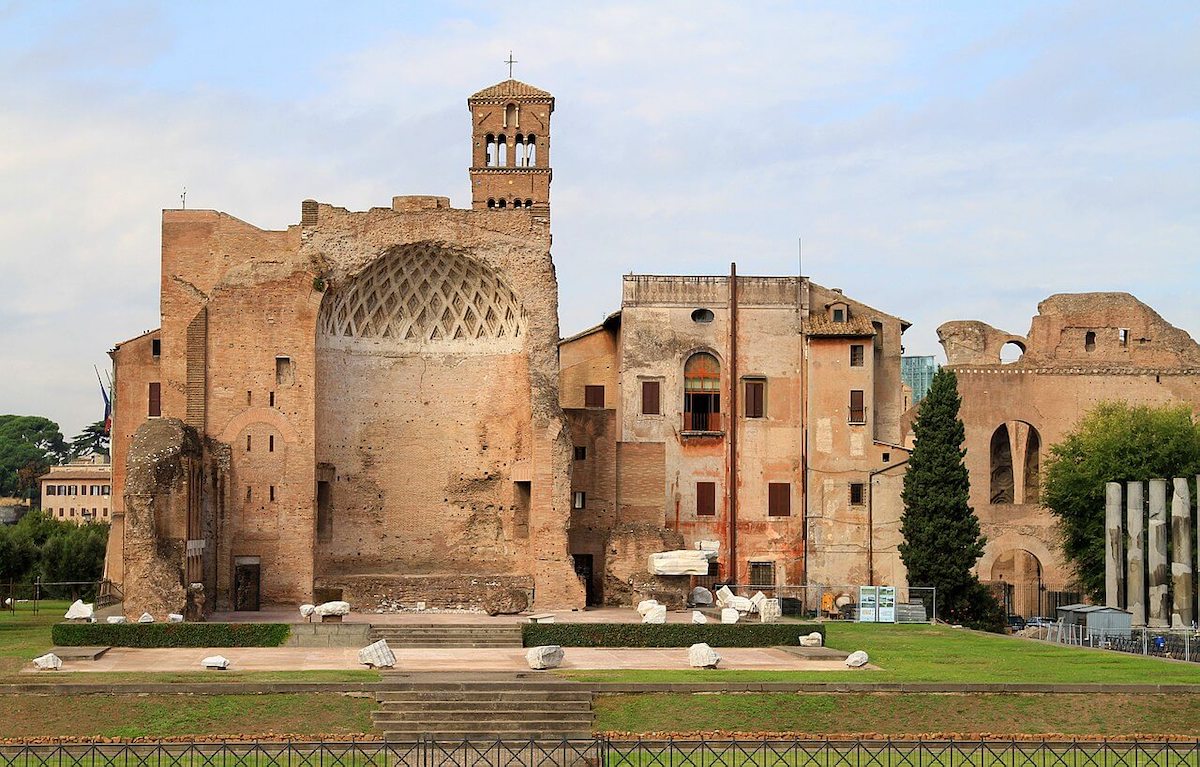Rome, the Eternal City with a thousand faces, among its wonders and its historical monuments, it can also boast the largest sacred building of antiquity. This is the temple of Venus and Rome built in 121 AD. by the emperor Adriano and located just a few steps from the Colosseum. The peculiarity of this temple, dedicated to Venus Felix and Rome Æterna it was undoubtedly its size. The audience on which he was placed extends in fact for 145 meters in length e 100 in width. In addition the building stood tall 10m with respect toFlavian Amphitheatre. The facility included approx 200 columns of granite and porphyry marble. In the east cell was the statue of the goddess Venus, mother of Aeneas and progenitor of the Genius Julia, while in the west cell was the statue of the goddess Rome (or the personification of the city).
History of the temple of Venus and Rome
Strongly wanted by the emperor Hadrian, its construction began in 121 AD on the project of Hadrian himself. Despite its inauguration in 136 (o 137) dC, the works ended only in 141 AD under the emperor Antoninus Pius, son of Adriano. The temple was built in the area where the atrium of the Domus Aurea di Nero. The latter included a colossus depicting the emperor, converted from Vespasian in Apollo statue after the fire of the Domus. To move the colossus towards the Colosseum, the help of 24 elephants. Despite the magnificence of the work, the architect Apollodorus of Damascus he was very critical of Adriano because of his architectural choices. According to Cassius Dio, the architect had criticized the size of the cells in which the statues of the two goddesses were located, considered too small ("If the goddesses wanted to rise from their thrones and leave, they would be unable to do so»). Apollodorus paid for this affront to the emperor with his life.
After a fire in the 307 AD, the emperor Maxentius he had it restored, making some changes to the structure of the temple, such as the addition of apses and times. The temple of Venus and Rome resisted over time, thanks to some restorations, but the structure then experienced a slow and inexorable decline. In the 625 pope Honorius I he had the brass tiles removed, to use on the roof of the Saint Peter Basilica in Vatican. In IX the temple was destroyed by an earthquake and the basilica of Santa Maria Nova (then Saint Frances of Rome). Between 1810 and 1817, during the'French administration of Rome, the first excavations were carried out in the area. Between 1932 e 1935 was started on floor restoration marble and raise the porphyry columns. Left to neglect in the following years, in 1984 new restoration interventions were carried out, completed only in 2010.
New restoration and reopening of the cell of the Goddess Rome
In recent months, thanks to new restoration interventions, the temple of Venus and Rome has been able to see its ancient splendor again. The works, started in half 2020 they lasted 15 months and they involved 60 professionals of the sector. All this was possible thanks also to the partnership of Archaeological Park of the Colosseum and sponsorship by Fendi, with a contribution of 2,5 million euro. This new intervention has led tocell opening dedicated to Goddess Rome and accessibility to the entire structure. This new restoration of the temple of Venus and Rome is great news not only for art history lovers, but for all visitors to the Capital who can finally fully enjoy this marvel made almost two thousand years ago by a project of the emperor Hadrian. A stop not to be missed, together with the Colosseum and the other great works of Ancient Rome.
Featured photo: © Carlo Pelagalli - Wikimedia Commons (CC BY-SA 3.0).





